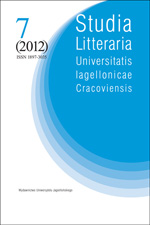Zadania tłumacza poezji konkretnej. Prolegomena metodologiczne (I)
Concrete Poetry Translator’s Tasks. Methodological Prolegomena
Author(s): Jakub KornhauserSubject(s): Literary Texts
Published by: Wydawnictwo Uniwersytetu Jagiellońskiego
Keywords: concrete poetry; visual poetry; translation of the experimental forms of literature; text as an object.
Summary/Abstract: The paper focuses on the methodological approach to the problem of translating experimental poetry. The presented analysis is based on three texts: Julian Kornhauser’s Przekład jako objaśnienie (O tłumaczeniu poezji konkretnej) from 1983, Jerzy Jarniewicz’s Tłumacze na urlop! and Leszek Engelking’s Konkretne decyzje tłumacza, both from 2006. Each of these three articles includes a translative strategy towards the concrete poetry. The term, in narrow meaning, can be used to describe the worldwide movement founded simultaneously in Switzerland/Germany (by Eugen Gomringer), Sweden (by Őyvind Fahlstrőm) and in Brazil (by the Noigandres group – Haroldo and Augusto de Campos and Décio Pignatari) in the early 1950s. The movement itself represents a form consisting of both verbal and visual elements and, in consequence, unites the distinctive marks of poetry and painting. With a vague status of a hybrid, as well as the experimental character, this specific genre is situated beyond the traditional categories of analysis and interpretation. Despite the confusion in terminology, though, there is fundamental requirement which the various kinds of concrete poetry meet: concentration upon the physical material from which the poem or text is made. Considered as an object, the concrete poem causes a fundamental problem in the frames of the translatology. The concrete poetry interpreters and researchers are disunited on the question of its translatabilty. Julian Kornhauser distinguishes the two major kinds of the concrete poem – a “poster-poem” and the “non-poster” one, the latter allowing or even requiring a translator’s intervention. The “poster-poem”, owing the complicated visual structure, cannot be translated. Jerzy Jarniewicz defines the entire concrete poetry as untranslatable, classifying it in the terms of the visual arts. Leszek Engleking presents a contrary view, which considers a translator as an interpret who promotes the experimental forms of poetry in the new literary context. The author of this paper attempts to put these methodological concepts into translation practice, examining the concrete poems of Eugen Gomringer, Friedrich Achleitner, Gerhard Rühm, Hansjörg Mayr and Jiří Kolář among others. While the most significant component of the concrete poem is language itself, treated predominantly as a graphic structure, the translation strategies can differ significantly. The analysis evokes its internal status, which appears to be miscellaneous from different perspectives, as it initiated an interdisciplinary genre by searching for new artistic horizons.
Journal: Studia Litteraria Universitatis Iagellonicae Cracoviensis
- Issue Year: 7/2012
- Issue No: 3
- Page Range: 119–133
- Page Count: 15
- Language: Polish

